Short-Term Contribution of Conservation Practice Implementation to Water Quality Impairments in Small Streams
Abstract
1. Introduction
- Quantify nutrient, sediment, and fecal indicator bacteria (pathogen surrogates) concentrations and loads in watershed tributaries prior to conservation implementation.
- Determine the short-term effects of conservation practice implementation on nutrient, sediment, and fecal indicator bacterial concentrations in the watershed.
2. Materials and Methods
2.1. Study Area
2.2. Study Design
2.3. Sampling Procedures
2.4. Pollutant Analysis
2.5. Statistical Analysis
3. Results
3.1. General Pollutant Concentrations and Loading
3.2. Reference vs. Treatment Site Concentrations and Loading
3.3. Pre- vs. Post-Implementation Concentrations and Loading
3.4. Fecal Indicator Bacteria Levels
4. Discussion
5. Conclusions
Author Contributions
Funding
Data Availability Statement
Acknowledgments
Conflicts of Interest
References
- U.S. Environmental Protection Agency. A National Evaluation of the Clean Water Act Section 319 Program; Office of Wetlands, Ocean, & Watersheds: Washington, DC, USA, 2011. [Google Scholar]
- U.S. Environmental Protection Agency. [Pie Graph of Assessed Rivers and Streams]. National Summary Water Quality Attainment in Assessed Rivers and Streams. Available online: https://ofmpub.epa.gov/waters10/attains_nation_cy.control (accessed on 1 January 2020).
- Evans, A.E.; Mateo-Sagasta, J.; Qadir, M.; Boelee, E.; Ippolito, A. Agricultural water pollution: Key knowledge gaps and research needs. Curr. Opin. Environ. Sustain. 2019, 36, 20–27. [Google Scholar] [CrossRef]
- Hooda, P.S.; Edwards, A.C.; Anderson, H.A.; Miller, A. A review of water quality concerns in livestock farming areas. Sci. Total Environ. 2000, 250, 143–167. [Google Scholar] [CrossRef]
- Jordan, M.A.; Casteneda, A.J.; Smiley, P.C.; Gillespie, R.B.; Smith, D.R.; King, D.R. Influence of instream habitat and water chemistry on amphibians in channelized agricultural headwater streams. Agric. Ecosyst. Environ. 2016, 230, 87–97. [Google Scholar] [CrossRef]
- Clary, C.R.; Redmon, L.; Gentry, T.; Wagner, K.; Lyons, R. Nonriparian shade as a water quality best management practice for grazing-lands: A case study. Rangelands 2016, 38, 129–137. [Google Scholar] [CrossRef]
- Zaimes, G.N.; Schultz, R.C.; Tufekcioglu, M. Gully and stream bank erosion in three pastures with different management in southeast Iowa. J. Iowa Acad. Sci. 2009, 116, 1–8. [Google Scholar]
- Baker, B.H.; Kroger, R.; Prevost, J.D.; Pierce, T.; Ramirez-Avila, J.J.; Prince Czarnecki, J.M.; Faust, D.; Flora, C. A field-scale investigation of nutrient and sediment reduction efficiencies of a low-technology best management practice: Low-grade weirs. Ecol. Eng. 2016, 91, 240–248. [Google Scholar] [CrossRef]
- Kroger, R.; Holland, M.M.; Moore, M.T.; Cooper, C.M. Agricultural drainage ditches mitigate phosphorus loads as a function of hydrological variability. J. Environ. Qual. 2008, 37, 107–113. [Google Scholar] [CrossRef]
- Ward, A.; Sharpley, A.; Miller, K.; Dick, W.; Hoorman, J.; Fulton, J.; LaBarge, G.A. An assessment of in-field nutrient best management practices for agricultural crop systems with subsurface drainage. J. Soil Water Conserv. 2018, 73, 5A–10A. [Google Scholar] [CrossRef]
- Osborne, L.L.; Kovacic, D.A. Riparian vegetated buffer strips in water-quality restoration and stream management. Freshw. Biol. 1993, 29, 243–258. [Google Scholar] [CrossRef]
- Musser, S.R.; Grafe, J.; Ortega-Achury, S.L.; Ramirez-Avila, J. Influence of riparian vegetation on stream health and water quality. In Proceedings of the World Environmental and Water Resources Congress 2019, Pittsburgh, PA, USA, 19–23 May 2019; pp. 59–67. [Google Scholar] [CrossRef]
- Noble-Cagle, T.; Musser, S.; Richardson, B.; Ramirez-Avila, J.J. Stream macroinvertebrate diversity and water quality of Catalpa Creek in Mississippi. In Proceedings of the World Environmental and Water Resources Congress 2019, Pittsburgh, PA, USA, 19–23 May 2019; pp. 68–77. [Google Scholar] [CrossRef]
- Yates, A.G.; Bailey, R.C.; Schwindt, J.A. Effectiveness of best management practices in improving stream ecosystem quality. Hydrobiologia 2007, 583, 331–334. [Google Scholar] [CrossRef]
- Baker, B.H.; Prince Czarnecki, J.M.; Omer, A.R.; Aldridge, C.A.; Kroger, R.; Prevost, J.D. Nutrient and sediment runoff from agricultural landscapes with varying suites of conservation practices in the Mississippi Alluvial Valley. J. Soil Water Conserv. 2018, 73, 75–85. [Google Scholar] [CrossRef]
- Kroger, R.; Prince Czarnecki, J.M.; Tank, J.L.; Christopher, S.F.; Witter, J.D. Implementing innovative drainage management practices in the Mississippi River Basin to enhance nutrient reductions. J. Am. Water Resour. Assoc. 2015, 51, 1020–1028. [Google Scholar] [CrossRef]
- Dabney, S.M.; Shields, F.D.; Bingner, R.L.; Kuhnle, R.A.; Rigby, J.R. Watershed management for erosion and sedimentation control case study: Goodwin Creek, Panola County, MS. In Soil Water and Agronomic Productivity; Lal, R., Stewart, B.A., Eds.; CRC Press: Boca Raton, FL, USA, 2012; pp. 539–556. ISBN 9781439850794. [Google Scholar]
- Shields, F.D.; Knight, S.S.; Cooper, C.M. Can warmwater streams be rehabilitated using watershed-scale standard erosion control measures alone? Environ. Manag. 2007, 40, 62–79. [Google Scholar] [CrossRef] [PubMed]
- Alexander, R.B.; Boyer, E.W.; Smith, R.A.; Schwarz, G.E.; Moore, R.B. The role of headwater streams in downstream water quality. J. Am. Water Resour. Assoc. 2007, 43, 41–59. [Google Scholar] [CrossRef] [PubMed]
- Dodds, W.K.; Oakes, R.M. Headwater influences on downstream water quality. Environ. Manag. 2008, 41, 367–377. [Google Scholar] [CrossRef]
- Meals, D.W.; Dressing, S.A.; Davenport, T.E. Lag time in water quality response to best management practices: A review. J. Environ. Qual. 2010, 39, 85–96. [Google Scholar] [CrossRef]
- Prokopy, L.S.; Genskow, K.; Asher, J.; Baumgart-Getz, A.; Bonnell, J.E.; Allread, S.B.; Curtis, C.; Floress, K.; McDermaid, K.; Power, R.; et al. Designing a regional system of social indicators to evaluate nonpoint source projects. J. Ext. 2009, 47, 1. [Google Scholar]
- Harmel, R.D.; King, K.W.; Haggard, B.E.; Wren, D.G.; Sheridan, J.M. Practical guidance for discharge and water quality data collection on small watersheds. Trans. ASABE 2006, 49, 937–948. [Google Scholar] [CrossRef]
- U.S. Environmental Protection Agency. Ambient Water Quality Criteria Recommendations: Information Supporting the Development of State and Tribal Nutrient Criteria for Rivers and Streams in Nutrient Ecoregion IX (EPA-822-B-00-019); Office of Water: Washington, DC, USA, 2000. Available online: https://www.epa.gov/sites/default/files/documents/rivers9.pdf (accessed on 1 January 2020).
- Ramirez-Avila, J.; Schauwecker, T.J.; Czarnecki Prince, J.M. Catalpa Creek Watershed Planning, Restoration, and Protection Project. In Proceedings of the XIX Conferenza Nazionale della Società Italiana degli Urbanisti (SIU), Catania, Italy, 16–18 June 2016. [Google Scholar]
- Mississippi Department of Environmental Quality. Mississippi 2016 Section 303(d) List of Impaired Water Bodies; Mississippi Department of Environmental Quality: Jackson, MS, USA, 2016. Available online: https://www.mdeq.ms.gov/wp-content/uploads/2017/06/2016_Adopted_Section_303d_List.pdf (accessed on 1 January 2020).
- Mississippi Department of Environmental Quality. Total Maximum Daily Load Tombigbee River Basin Designated Streams in HUC 03160104 (Tibbee Creek) for Impairment Due to Sediment; Mississippi Department of Environmental Quality: Jackson, MS, USA, 2007. Available online: https://www.mdeq.ms.gov/wp-content/uploads/2006/12/TombigbeeRB03160104SedimentJan07.pdf (accessed on 1 January 2020).
- Mississippi State University. Water Resources Management Plan for the Red Bud-Catalpa Creek Watershed. Available online: https://www.cee.msstate.edu/wp-content/uploads/WRMP.pdf (accessed on 1 January 2020).
- Natural Resources Conservation Service, U.S. Department of Agriculture. NRCS Field Office Technical Guide; Natural Resources Conservation Service: Washington, DC, USA, 2020.
- U.S. Geological Survey. The StreamStats Program for Mississippi. Available online: http://water.usgs.gov/osw/streamstats/mississippi.html (accessed on 1 January 2020).
- Decker, C.; Simmons, K. Surface Water Sampling [SESDPROC-201-R3]; Region 4 USEPA Science and Ecosystem Support Division: Athens, GA, USA, 2013. [Google Scholar]
- Clesceri, L.S.; Greenberg, A.E.; Eaton, A.D. Standard Methods for the Examination of Water and Wastewater, 20th ed.; American Public Health Association: Washington, DC, USA, 2013. [Google Scholar]
- Santiago-Rodriguez, T.; Kinzelman, J.; Toranzos, G. Current and developing methods for the detection of microbial indicators in environmental freshwaters and drinking waters. In Manual of Environmental Microbiology, 4th ed.; Yates, M., Nakatsu, C., Miller, R., Pillai, S., Eds.; ASM Press: Washington, DC, USA, 2015; ISBN 978-1-683-67074-2. [Google Scholar]
- U.S. Environmental Protection Agency. Method 1103.1: Escherichia coli (E. coli) in Water by Membrane Filtration Using Membrane-Thermotolerant Escherichia coli Agar (mTEC) (EPA-821-R-10-002); Office of Water: Washington, DC, USA, 2010.
- Brooks, J.P.; Smith, R.K.; Aldridge, C.A.; Chaney, B.; Omer, A.; Dentinger, J.; Street, G.M.; Baker, B.H. A preliminary investigation of wild pig (Sus scrofa) impacts in water quality. J. Environ. Qual. 2020, 49, 27–37. [Google Scholar] [CrossRef]
- Rhodehamel, E.J.; Harmon, S.M. Clostridium perfringens. In Bacteriological Analytical Manual, 8th ed.; FDA: Silver Spring, MD, USA, 2001. [Google Scholar]
- Hirsch, R.M.; Slack, J.R. A nonparametric trend test for seasonal data with serial dependence. Water Resour. Res. 1984, 20, 727–732. [Google Scholar] [CrossRef]
- Shapiro, S.S.; Wilk, M.B.; Chen, H.J. A comparative study of various tests for normality. J. Am. Stat. Assoc. 1968, 63, 1343–1372. [Google Scholar] [CrossRef]
- Hathaway, J.M.; Krometis, L.H.; Hunt, W.F. Exploring seasonality in Escherichia coli and fecal coliform ratios in urban watersheds. J. Irrig. Drain. Eng. 2014, 140, 04014003. [Google Scholar] [CrossRef]
- Bates, D.; Maechler, M.; Bolker, B.; Walker, S. Fitting linear mixed-effects models using lme4. J. Stat. Softw. 2015, 67, 1–48. [Google Scholar] [CrossRef]
- National Oceanic and Atmospheric Administration. Map of Annual Precipitation Totals (Advanced Hydrologic Precipitation Service Precipitation Analysis). Available online: https://water.weather.gov/precip/ (accessed on 1 January 2020).
- Buck, O.; Niyogi, D.K.; Townsend, C.R. Scale-dependence of land use effects on water quality of streams in agricultural catchments. Environ. Pollut. 2004, 130, 287–299. [Google Scholar] [CrossRef] [PubMed]
- Peterson, B.J.; Wollheim, W.M.; Mulholland, P.J.; Webster, J.R.; Meyer, J.L.; Tank, J.L.; Marti, E.; Bowden, W.B.; Valett, H.M.; Hershey, A.E.; et al. Control of nitrogen export from watersheds by headwater streams. Science 2001, 292, 86–90. [Google Scholar] [CrossRef] [PubMed]
- Weidhaas, J.; Anderson, A.; Jamal, R. Elucidating waterborne pathogen presence and aiding source apportionment in an impaired system. Appl. Environ. Microbiol. 2018, 84, 1–13. [Google Scholar] [CrossRef] [PubMed]
- Wagner, K.L.; Gregory, L.; Gerlich, J.A.; Rhodes, E.C.; deVilleneuve, S. Edge-of-field runoff analysis following grazing and silvicultural best management practices in northeast Texas. Water 2023, 15, 3537. [Google Scholar] [CrossRef]
- Ferguson, C.M.; Coote, B.G.; Ashbolt, N.J.; Stevenson, I.M. Relationships between indicators, pathogens, and water quality in an estuarine system. Water Resour. 1996, 30, 2045–2054. [Google Scholar] [CrossRef]
- Fraser, R.H.; Barten, P.K.; Pinney, D.A. Predicting stream pathogen loading from livestock using a geographical information system-based delivery model. J. Environ. Qual. 1998, 27, 935–945. [Google Scholar] [CrossRef]
- Sinton, L.W.; Braithwaite, R.R.; Hall, C.H.; Mackenzie, M.L. Survival of indicator and pathogenic bacteria in bovine feces on pasture. Appl. Environ. Microbiol. 2007, 73, 7917–7925. [Google Scholar] [CrossRef]
- Lowrance, R.; Altier, L.S.; Newbold, J.D.; Schnabel, R.R.; Groffman, P.M.; Denver, J.M.; Correll, D.L.; Gilliam, J.W.; Robinson, J.L.; Brinsfield, R.B.; et al. Water quality functions of riparian forest buffers in Chesapeake Bay watersheds. Environ. Manag. 1997, 21, 687–712. [Google Scholar] [CrossRef] [PubMed]
- Mayer, P.M.; Reynolds, S.K.; McCutchen, M.D.; Canfield, T.J. Meta-analysis of nitrogen removal in riparian buffers. J. Environ. Qual. 2007, 36, 1172–1180. [Google Scholar] [CrossRef] [PubMed]
- Valkama, E.; Usva, K.; Saarinen, M.; Uusi-Kamppa, J. A meta-analysis of nutrient retention by buffer zones. J. Environ. Qual. 2018, 48, 270–279. [Google Scholar] [CrossRef] [PubMed]
- Simon, A. A model of channel response in disturbed alluvial channels. Earth Surf. Process. Landf. 1989, 14, 11–26. [Google Scholar] [CrossRef]
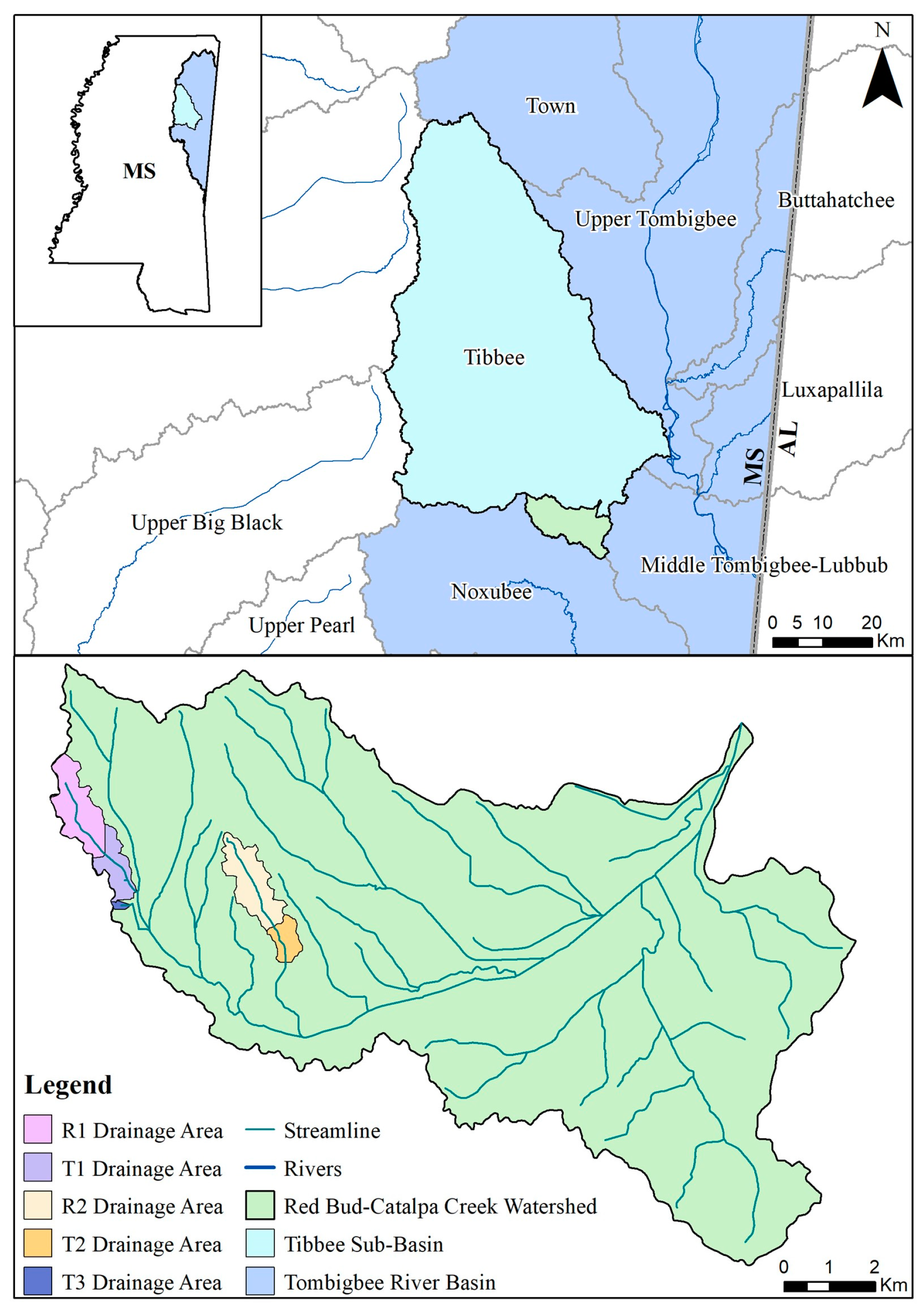
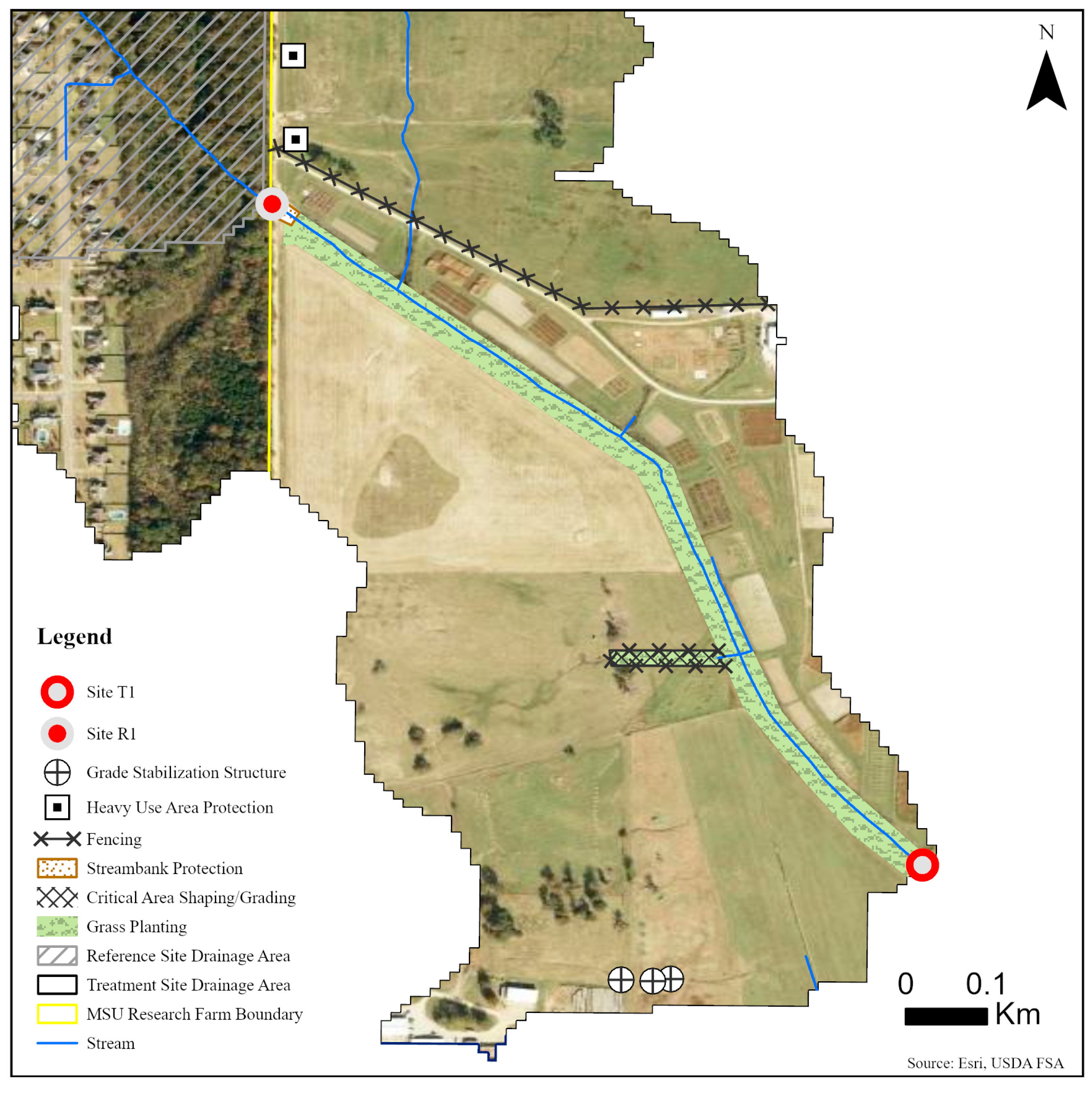
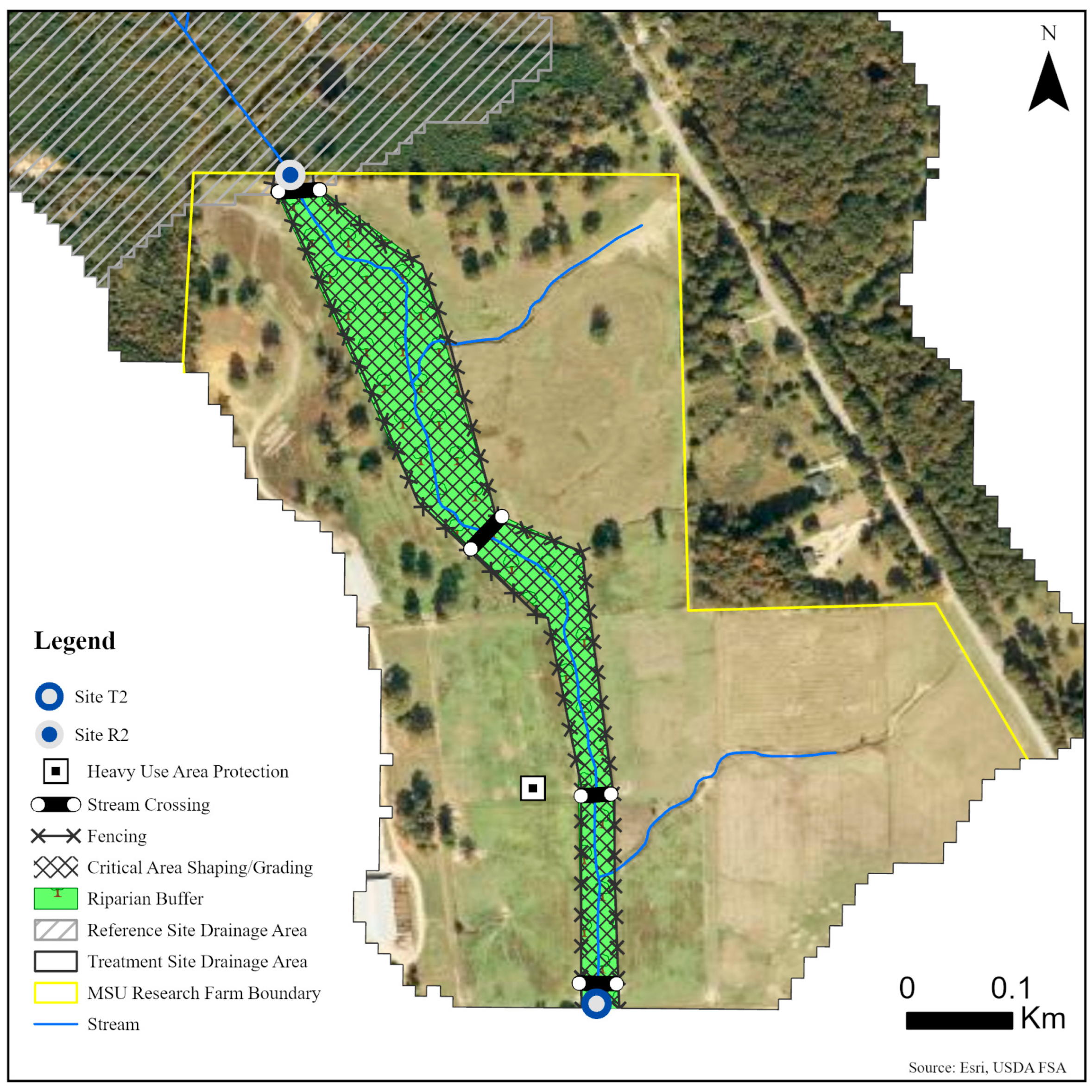
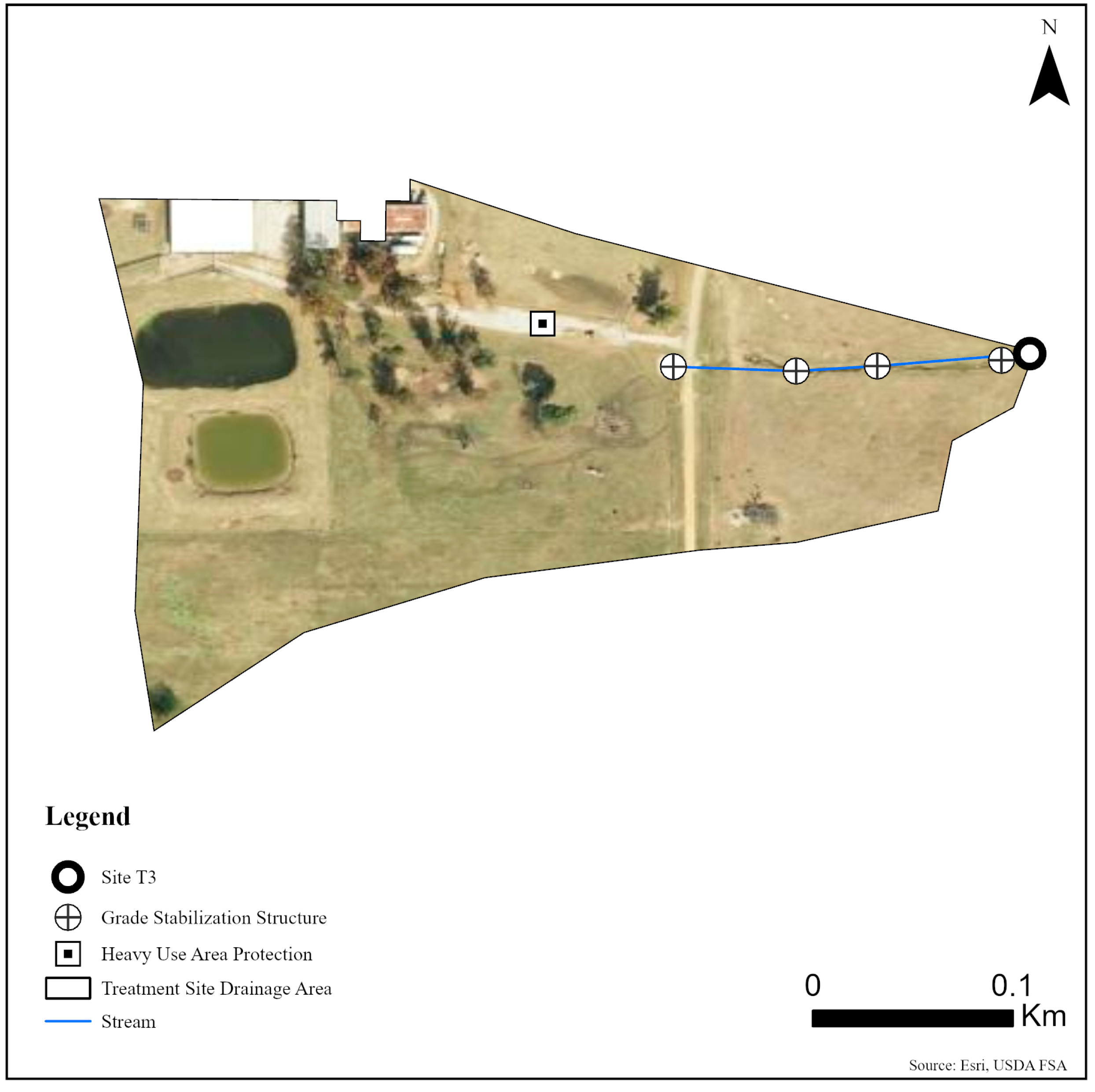
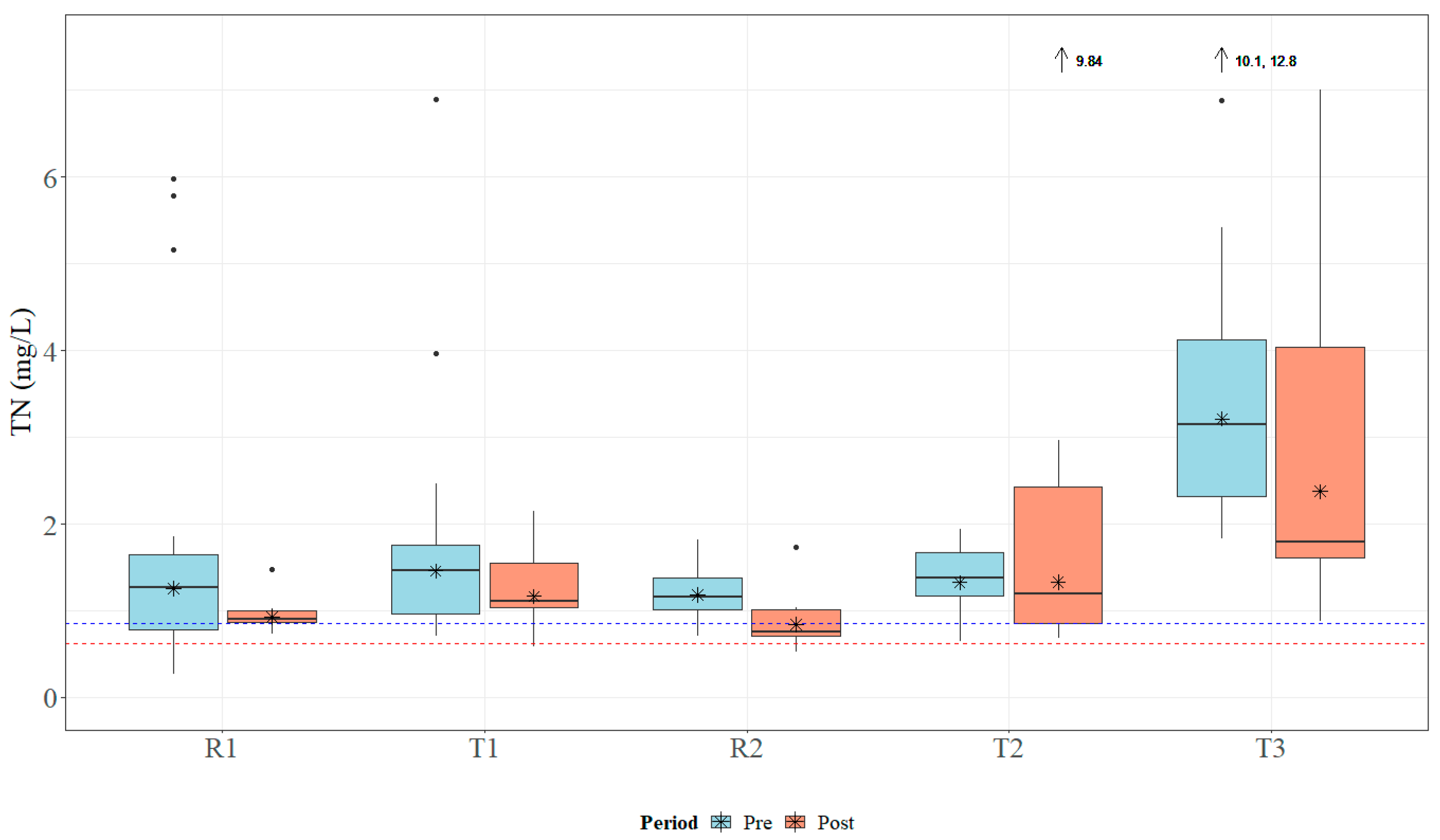

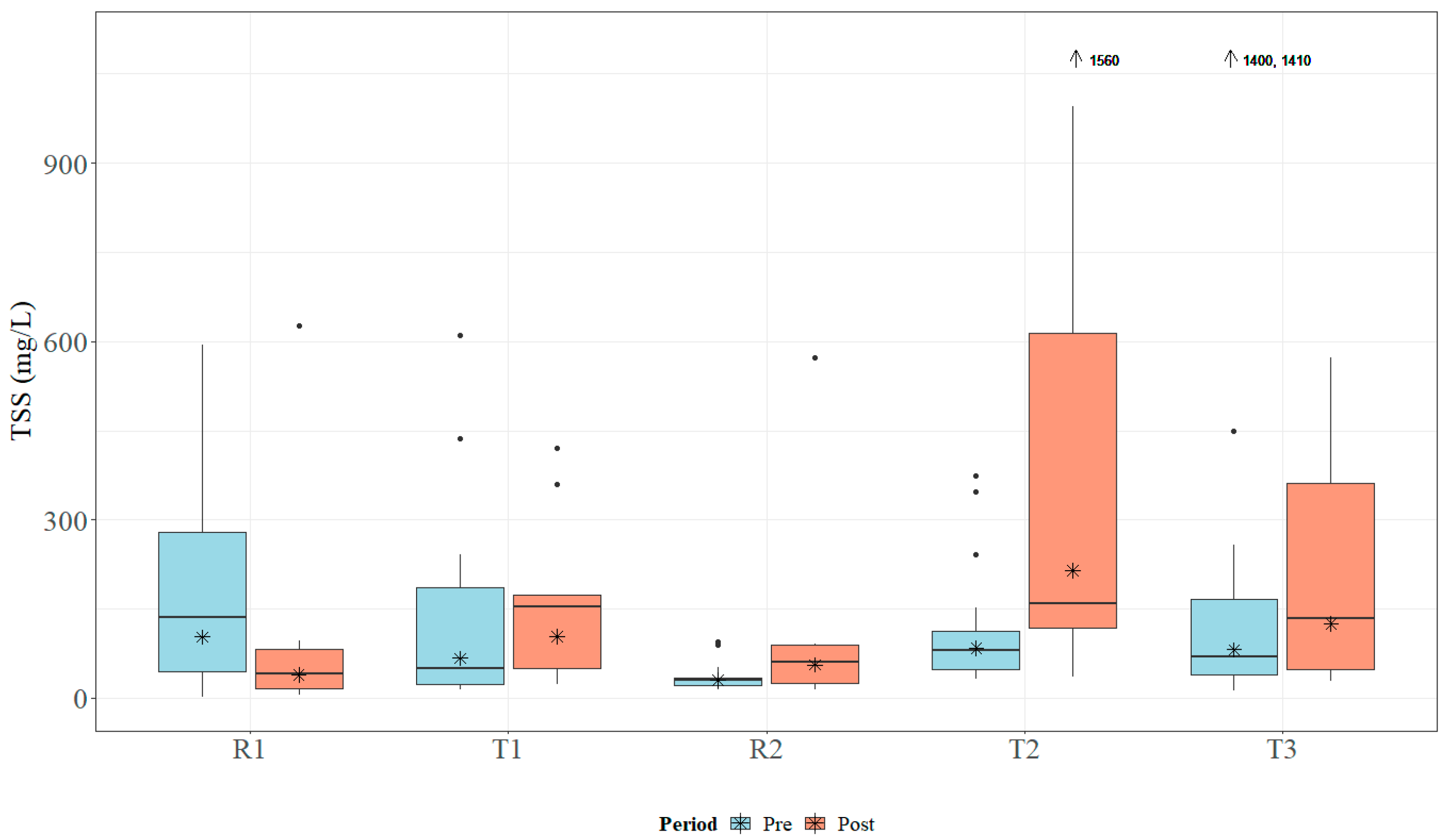
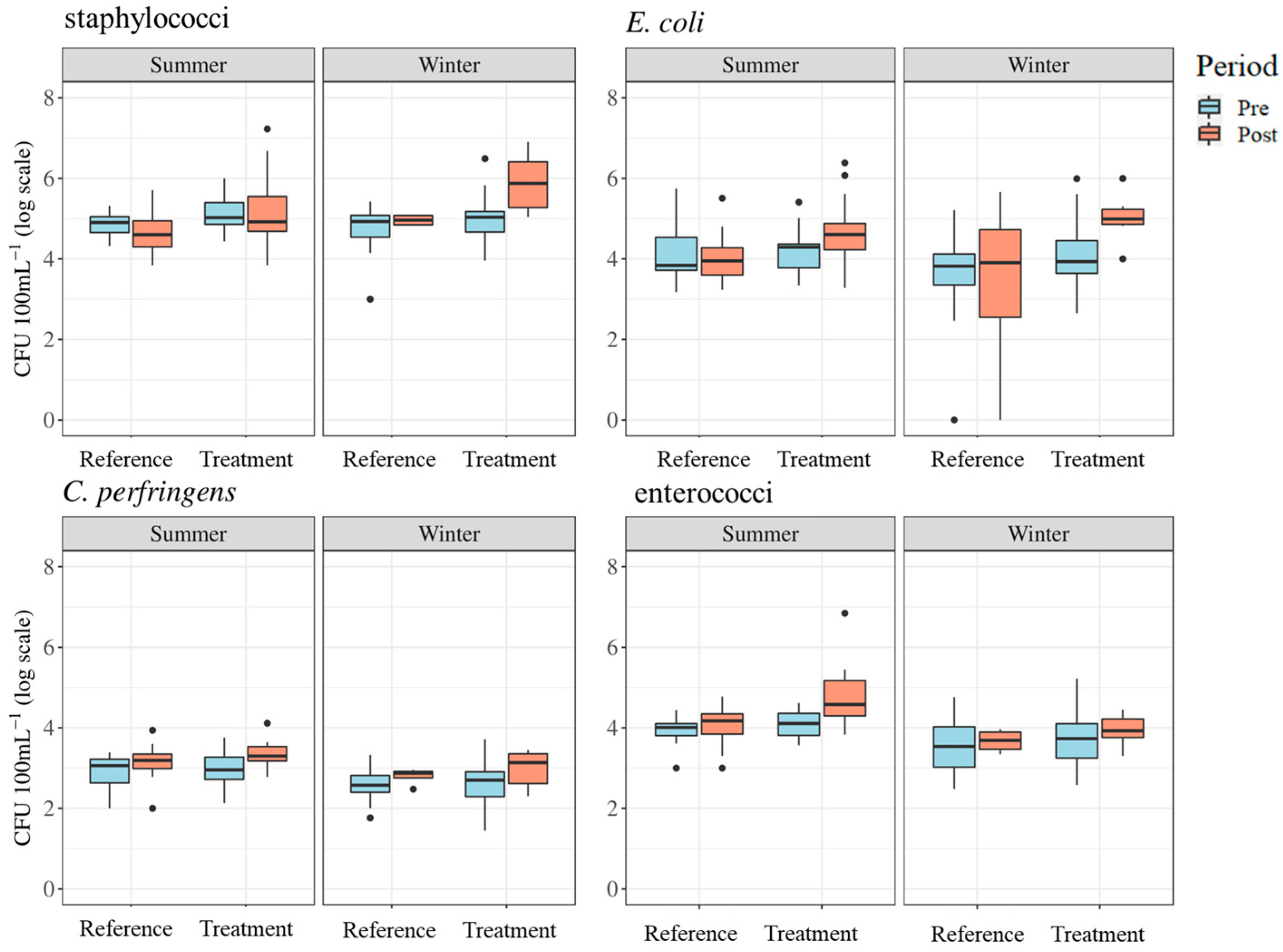
| Site | Period | n | TN (mg L−1) | TP (mg L−1) | TSS (mg L−1) | |||
|---|---|---|---|---|---|---|---|---|
| Median | IQR | Median | IQR | Median | IQR | |||
| R1 | Pre | 23 | 1.27 | 0.87 | 0.37 | 0.205 | 136 | 235 |
| Post | 11 | 0.90 | 0.13 | 0.51 | 0.47 | 41 | 66.5 | |
| T1 | Pre | 21 | 1.46 | 0.79 | 1.44 | 1.49 | 50 | 163 |
| Post | 9 | 1.11 | 0.51 | 0.24 | 0.155 | 154 | 123 | |
| R2 | Pre | 20 | 1.16 | 0.37 | 0.54 | 0.31 | 30 | 13 |
| Post | 8 | 0.76 | 0.31 | 1.71 | 0.78 | 60 | 64.5 | |
| T2 | Pre | 20 | 1.38 | 0.51 | 0.21 | 0.1175 | 80.5 | 65.75 |
| Post | 10 | 1.32 | 1.58 | 0.42 | 0.665 | 213.5 | 555.75 | |
| T3 | Pre | 19 | 3.82 | 2.36 | 0.28 | 0.12 | 77 | 145.5 |
| Post | 9 | 1.79 | 2.43 | 0.29 | 0.13 | 135 | 314 | |
| Site | 1 Discharge (L) | Area (ha) | TN (kg ha−1) | TP (kg ha−1) | TSS (kg ha−1) | |||
|---|---|---|---|---|---|---|---|---|
| Pre | Post | Pre | Post | Pre | Post | |||
| R1 | 13,602,890 | 148 | 0.12 | 0.08 | 0.03 | 0.03 | 12.53 | 3.78 |
| T1 | 26,256,335 | 225 | 0.17 | 0.13 | 0.06 | 0.06 | 5.83 | 17.94 |
| R2 | 22,064,421 | 145 | 0.18 | 0.12 | 0.04 | 0.03 | 4.56 | 9.13 |
| T2 | 35,832,818 | 194 | 0.25 | 0.24 | 0.05 | 0.08 | 14.85 | 39.38 |
| T3 | 1,087,071 | 5.5 | 0.76 | 0.36 | 0.29 | 0.34 | 15.32 | 26.85 |
| Fecal Indicator Bacteria | Period | Summer | Winter | ||||
|---|---|---|---|---|---|---|---|
| n | Treatment (CFU 100 mL−1) | Reference (CFU 100 mL−1) | n | Treatment (CFU 100 mL−1) | Reference (CFU 100 mL−1) | ||
| Staphylococci | pre | 20 | 135,563 | 74,739 | 68 | 99,570 | 60,340 |
| post | 36 | 144,622 | 43,535 | 10 | 781,518 | 91,652 | |
| E. coli | pre | 20 | 15,616 | 13,489 | 68 | 11,131 | 4607 |
| post | 36 | 42,313 | 10,441 | 10 | 104,037 | 2333 | |
| C. perfringens | pre | 20 | 918 | 678 | 68 | 407 | 413 |
| post | 36 | 2170 | 1423 | 10 | 961 | 624 | |
| Enterococci | pre | 20 | 12,791 | 8670 | 68 | 5168 | 3661 |
| post | 36 | 50,446 | 11,024 | 10 | 8621 | 4679 | |
| Fecal Indicator Bacteria | Season | Pre: Post-Treatment Periods | Reference Sites: Treatment Sites | Treatment Period: Treatment Sites |
|---|---|---|---|---|
| Staphylococci | Summer | 0.869 | 0.1728 | 0.5058 |
| Winter | 0.49096 | * 0.03698 | * 0.02244 | |
| E. coli | Summer | 0.92435 | 0.79609 | 0.08203 |
| Winter | 0.63625 | * 0.04101 | * 0.02262 | |
| C. perfringens | Summer | 0.2025 | 0.583 | 0.4796 |
| Winter | 0.4622 | 0.8205 | 0.5399 | |
| Enterococci | Summer | 0.5848 | 0.5021 | 0.1003 |
| Winter | 0.7268 | 0.0556 | 0.8053 |
Disclaimer/Publisher’s Note: The statements, opinions and data contained in all publications are solely those of the individual author(s) and contributor(s) and not of MDPI and/or the editor(s). MDPI and/or the editor(s) disclaim responsibility for any injury to people or property resulting from any ideas, methods, instructions or products referred to in the content. |
© 2024 by the authors. Licensee MDPI, Basel, Switzerland. This article is an open access article distributed under the terms and conditions of the Creative Commons Attribution (CC BY) license (https://creativecommons.org/licenses/by/4.0/).
Share and Cite
McCrary, A.; Brooks, J.P.; Smith, R.K.; Burger, L.M.; Lucore, A.; Ramirez-Avila, J.J.; Schauwecker, T.; Prince Czarnecki, J.M.; Burger, L.W., Jr.; Baker, B.H. Short-Term Contribution of Conservation Practice Implementation to Water Quality Impairments in Small Streams. Water 2024, 16, 261. https://doi.org/10.3390/w16020261
McCrary A, Brooks JP, Smith RK, Burger LM, Lucore A, Ramirez-Avila JJ, Schauwecker T, Prince Czarnecki JM, Burger LW Jr., Baker BH. Short-Term Contribution of Conservation Practice Implementation to Water Quality Impairments in Small Streams. Water. 2024; 16(2):261. https://doi.org/10.3390/w16020261
Chicago/Turabian StyleMcCrary, Audrey, John P. Brooks, Renotta K. Smith, Leslie M. Burger, Andrew Lucore, John J. Ramirez-Avila, Tim Schauwecker, Joby M. Prince Czarnecki, Loren Wes Burger, Jr., and Beth H. Baker. 2024. "Short-Term Contribution of Conservation Practice Implementation to Water Quality Impairments in Small Streams" Water 16, no. 2: 261. https://doi.org/10.3390/w16020261
APA StyleMcCrary, A., Brooks, J. P., Smith, R. K., Burger, L. M., Lucore, A., Ramirez-Avila, J. J., Schauwecker, T., Prince Czarnecki, J. M., Burger, L. W., Jr., & Baker, B. H. (2024). Short-Term Contribution of Conservation Practice Implementation to Water Quality Impairments in Small Streams. Water, 16(2), 261. https://doi.org/10.3390/w16020261








